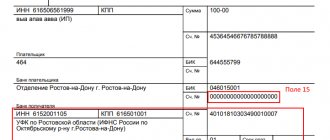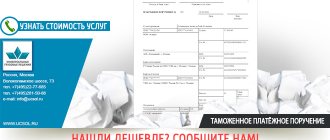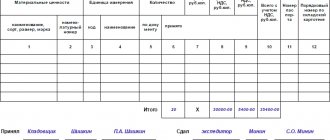A forwarding receipt is issued when an enterprise engages a third-party transportation company to transport inventory items. This document is included in the mandatory set of forwarding documents and is an annex to the agreement between the shipper or consignee and the transport organization. It refers to primary documentation and therefore it is necessary to treat its preparation carefully, observing all the norms and requirements established for this type of paper.
- Form and sample
- Online viewing
- Free download
- Safely
FILES
What it is
The following persons take part in the transportation of cargo:
- client is the owner of the cargo;
- carrier - an organization directly transporting cargo;
- forwarder is a company that organizes transportation on behalf and at the expense of the client. The forwarder has the right to take over the functions of the carrier or hire a third party; a forwarding receipt is a document related to the activities of the company organizing the transportation.
This document records the fact of receipt of goods in a certain completeness and with certain characteristics. What a forwarding receipt is is disclosed in the rules approved by Decree of the Government of the Russian Federation dated September 8, 2006 No. 554, where it is listed among other required papers. The receipt records important data about the product, including weight, packaging and cost, so the document is useful and necessary for both parties. The composition of the information contained in the document answers the question of why a forwarding receipt is needed:
- It relieves the client-sender of responsibility for the safety of the cargo during transportation, since by accepting the goods in the form recorded in it, the forwarder assumes all risks associated with its transportation and possible damage.
- For the transportation organizer, this is an opportunity to record the actual condition of the goods at the time of shipment, so that later certain defects that arose before the transfer would not be attributed to carelessness during transportation.
Features of the document
This type of document confirms that the warehouse has assumed obligations and responsibilities for storing the items transferred to it for the period specified in the executed receipt and for a certain payment, and also provides the owner of the item with the opportunity to receive his goods (part of them) back at any time without difficulties or obstacles.
A warehouse receipt is drawn up by an employee of an organization engaged in this type of activity and is handed over to the depositor personally or to persons acting on the basis of powers of attorney, duly executed. Documents cannot be transferred to third parties using an endorsement, since they are not securities, unlike simple and double warehouse receipts.
When accepting property by authorized employees of organizations and drawing up a warehouse receipt, the following activities are carried out, which are then reflected in the text of the document:
- the quantity of property to be rented is determined;
- the types (types) of things transferred and their condition at the time of concluding the storage agreement are specified through documentation.
Based on the issued receipt, the owner of the property at any time during the storage period has the right to inspect the handed over inventory items, their condition and safety
Is it necessary to use the form?
The rules consider forwarding papers as an integral part of the transport expedition agreement. Therefore, at first glance, it follows that a transport receipt is mandatory, and without it the existence of a contract is impossible. But paragraph 6 of the rules states that by agreement of the parties, if required by the nature of their relationship, the use of other transfer documents not provided for by the rules is allowed. This confirms that a forwarding receipt is not required. The parties must draw up some kind of transfer paper that would record the fact of transfer of goods from the client to the forwarder, but, by agreement, the use of the approved form is not necessary.
How to draw up a forwarding receipt
Today, the forwarding receipt does not have a strictly established template, so it can be drawn up in any form or on the basis of a template developed within the enterprise (which must be approved in the company’s accounting policies). Some organizations, in the old fashioned way, prefer to use the previously mandatory document form, since it contains all the necessary information.
The receipt must include information about:
- shipper company,
- recipient of the goods,
- personal data of the forwarder (his last name, first name and patronymic),
- date and number of the document,
- some information about the cargo (weight, packaging, number of occupied spaces, etc. parameters).
The receipt is almost similar to another transport document accompanying the cargo - an order to the forwarder.
Errors, and even more so unreliable or deliberately false information, cannot be allowed in the document, since subsequently, under certain circumstances, it can become a legally significant document required in court. If an incident occurs and some inaccuracy is still made, it is better not to correct it, but to create a new document.
Who compiles and when
Clause 12 of the rules establishes the obligation to draw up a transfer document for the forwarder; the same clause establishes that the forwarding receipt is issued to the client as confirmation of the fact of cargo transportation. Handover is the moment when the goods pass into the possession of the forwarder, in which they remain until they are returned to the client or transferred to another person designated by the client.
It is important to distinguish a transfer paper from a waybill, including understanding whether a forwarding receipt is issued instead of a waybill. A consignment note is a document issued by the cargo carrier. This obligation is enshrined in paragraph 1 of Art. 8 of the Federal Law of November 8, 2007 No. 259-FZ. Thus, if the organizer hires a third party as a carrier, a TTN must be drawn up. The organizer has the right to transport the cargo independently, without involving third parties; in this case, transfer documents are sufficient for him, and registration of the consignment note is not mandatory. That is, speaking about whether the TN replaces the forwarding receipt, we state that no, these are two different documents.
Who applies and is it mandatory or not?
From the name of the forwarding receipt it already becomes clear that it is drawn up by the forwarding agent. He must formalize it at the time the cargo is transferred to him. The client must pay the invoice for transportation. Since it includes information about the object of transportation, the sender provides it to the person responsible for transportation.
To account for income tax expenses, you need a package of transportation papers, including a receipt, that is, in other words, a document confirming that the person responsible for transportation accepted the cargo. Thus, the receipt is a mandatory document for accounting and tax purposes.
What are the requirements?
The forms of documents listed in the rules, including the form of the forwarding receipt, were approved by Order of the Ministry of Transport of the Russian Federation dated February 11, 2008 No. 23. The same document approved the procedure for their execution. The following requirements apply to the document:
- the form is printed typographically on an A4 sheet, font No. 14;
- the name of the document is written in font No. 16, bold;
- it is allowed to fill out the form by machine or by hand with a blue or black pen; blots or corrections are not allowed in the document;
- drawn up in two copies: one is given to the client, the other remains with the forwarder;
- the document is signed by a representative of the company organizing the transportation; a stamp on the forwarding receipt is not required.
Does it replace the waybill?
In order to understand whether such documents are interchangeable, let’s consider two situations.
The first situation is that if a forwarder signs an agreement with a company specializing in transportation, then he needs an invoice for the goods. But its preparation does not negate the fact that it is necessary to fill out a receipt. That is, the following picture emerges: the sender transfers the cargo to the forwarder, and a receipt is drawn up that the cargo was received by the forwarder. Purely theoretically, during this period of time and during the transportation period, the cargo belongs to him. Next, the shipment is transferred to the transport company, which, in turn, fills out the transport bill of lading and gives it to the forwarder.
The second situation: if the forwarder transports the cargo himself. In such a situation, a waybill is not required.
But in any case, the receipt does not replace the invoice; these are two different documents and they are drawn up differently, and are intended for different purposes and are accounted for differently in accounting.
In addition, companies providing cargo transportation services are required to fill out travel forms.
Procedure for compilation
During registration, the transportation organizer fills out the following fields of the form sequentially:
- Date of issue.
- Number.
- Name or full name shipper.
- Name or full name client. The customer and the shipper may be the same.
- Name or full name company or individual entrepreneur providing forwarding services.
- Country of origin of the product.
- Product code.
- Cargo marking.
- Number of packages indicating the method of transportation, for example: in boxes, boxes, in bulk.
- Gross/net cargo weight.
- Cargo volume.
- Cost - in accordance with payment documents, this is the cost of the cargo, the cost of the expedition itself is not indicated.
- Dimensions and weight of each package.
- Conditions for acceptance of cargo by the forwarder.
- Additional information about the cargo that is required by the forwarder for the proper fulfillment of obligations.
- Forwarder's signature with transcript.
Procedure for registration and forms of forwarding documents
Based on all the rules proposed by the government (and supervisory government bodies), it is possible to formulate clear instructions for filling out the receipt in question. A person who wants to carry out an operation in compliance with all standards must:
- Take a blank A4 sheet or the organization’s letterhead, and then put the current date and the corresponding serial numbering on it.
- Enter information about the consignor and consignee - legal names of institutions, actual addresses, telephone numbers.
- Fill out the block about the forwarder - the name of a specific company or full name (as well as passport details) of the responsible person.
- List the characteristics of the batch and its individual elements: number of spaces occupied, country of production, labeling, barcodes, articles, etc.
- Enter the category of packaging (boxes, containers, tanks, barrels, containers, etc.), as well as provide information about cost, volume and weight.
- Specify the terms of delivery, affix a signature with a transcript and the seal of the organization.
The certificate can be created either electronically or in paper form, depending on personal preferences and the internal document flow policy of the sending company. As mentioned earlier, an example of filling out a forwarding receipt can be found in Order of the Ministry of Transport of the Russian Federation No. 23 dated August 11, 2008.
What will happen if you don’t make up
Speaking about what will happen if you do not draw up the transfer paper, it is important to remember why you need a forwarding receipt. This is a document that protects the interests of both parties, without which the legal transfer of responsibility for the cargo from one party to the other will not take place, and subsequently the parties will not be able to present any claims to each other regarding the execution of the contract. At the same time, the legislator allows the execution of another paper instead of the established form, which would contain all the necessary information about the goods and the moment of its transfer to the forwarder. Provided that such paper is drawn up, the form is not mandatory.
Accounting side of the issue
It may seem that only the client needs a correctly completed receipt, but in fact the forwarding company itself is also interested in it. After all, the receipt indicates the acceptance of the cargo and the transfer of rights to its temporary possession.
Important! The receipt does not confirm the client’s expenses, since it does not indicate the cost of the services provided by the forwarder, but only how much the cargo costs.
However, the document is included in the mandatory package of papers that confirm the very fact of the provision of services, along with the invoice, transportation documents, the forwarder’s report and the contract itself. This package, by the way, is necessary for both parties to the transaction at once: the recipient - in order to apply deductions from VAT, while the forwarder - to confirm the rights to use the zero rate.
Civil Code of the Russian Federation. Part 2. Articles 805 and 806
Validity
The most significant aspect of a power of attorney intended for sending or receiving transport cargo is the validity period of the document.
A power of attorney can be issued:
- to perform one action or a series of actions during one visit to the company (one-time power of attorney). In this situation, it is recommended to indicate the list of actions and the date of the transaction with the transport company. In exceptional cases, for example, when the representative is busy, you can specify a validity period of 1-2 days
- for a certain period (month, year, three years, five years, and so on). A document containing a certain period of validity is a general power of attorney
How to become a freight forwarder?
As a rule, the work of a freight forwarder requires a higher technical or economic education (sometimes a secondary specialized education is sufficient). What a forwarder needs to know is a foreign language (some of the most popular are English, German, French, Polish) at a level sufficient for effective communication with foreign clients and partners. Moreover, the more languages you know, the higher you will be valued as a specialist, but you should not forget about your work experience. On our website you can find information about freight forwarder courses in Minsk, St. Petersburg, Moscow, Riga, Odessa, Kyiv, Vladivostok
A few words about
Most likely, all residents of the Russian Federation know this type of transport.
It is widely used by both individuals and legal entities - various enterprises, organizations, etc. It should be noted that this company provides not only the transportation of this or that cargo, but also a number of other useful services for its clients. The most convenient service, in particular for large settlements, “Business Lines” offers targeted delivery of cargo, which allows the recipient to stay in place and wait for his order right at home. A similar service is provided for collecting cargo not from the department, but from the address specified by the customer. Like other similar transport companies, they are engaged in storing cargo and packaging it. To order this service, you just need to call the hotline, and the rest will be done by the staff of this company. In cases where the weight of the cargo does not exceed 3 kg, customers can use the so-called courier delivery within a particular region.
An important feature of this transport company is the international transportation service, which clients can also order by contacting any branch of Business Lines.
In what situations is a power of attorney issued?
According to practice, individuals practically do not draw up trust documents to receive cargo. However, absolutely every citizen can draw up such a document. This is mainly done in the case when the recipient is unable to receive this or that parcel, and he transfers this right to a certain person who is an official trustee.
As a rule, such papers are drawn up by purely legal entities, namely organizations, enterprises, etc., since they quite often need to send or receive various products or documentation. Consequently, such rights can be owned not only by the head of the organization, but also by any other person who is an attorney, in accordance with the executed power of attorney.
As you have already noted, the general director of an enterprise can issue a similar document not only for a full-time employee of his institution, but also for another third party. The main requirement for such a person is his full legal capacity. Today there are already quite a few reasons why such a power of attorney should be drawn up. At the same time, the sender and recipient do not have any significant restrictions. The only thing you need to remember is that the sending cargo did not in any way contradict the current legislation of the Russian Federation.










